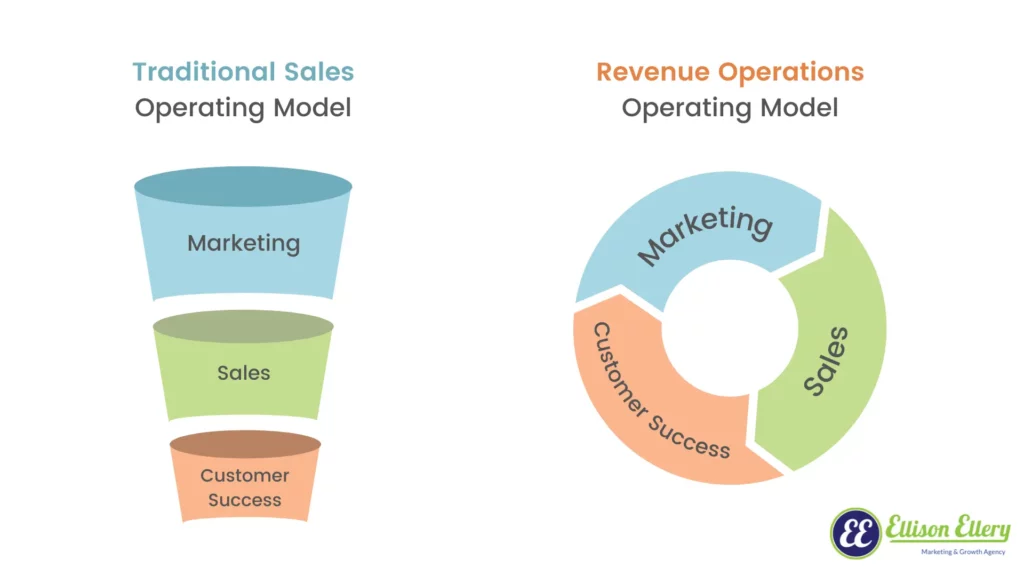You could be doing crazy good marketing, closing deals like a champ—and still miss out on the bottom line: revenue.
Mistakes during your marketing to sales hand-off cost you leads. You miss opportunities to upsell and cross-sell to existing customers because it’s only an afterthought. And you don’t give your customer support team the attention it deserves, driving your churn rate (rate of customers lost) up.
To maximize your profitability your company has to run like one well-oiled machine.
Revenue Operations will help you achieve this.
So, ask yourself “Exactly what is Revenue Operations?” no longer and read on to find out how the RevOps approach will help you optimize for long-term growth by increasing your retention rate and decreasing your churn (lost customers) rate — ultimately increasing your net sales!
Table of Contents

What is Revenue Operations?
Operations is about understanding the inner mechanics of your business’ approach to sales and making it run as efficiently as possible.
Revenue Operations (RevOps) are operations of all departments responsible for generating revenue: marketing, sales, and customer support.
Since more than one department is responsible for the quality of your sales, start looking at what it takes to max out your revenue (sales, upsells, and cross-sells) across each department. This will generate more revenue because all of your company’s plans, processes, and work streams are orchestrated to work as efficiently as possible.
This shift in thinking puts the focus on what really matters in your business and sets you up for long-term growth.

Why Revenue Operations is important for your business
If this sounds like a lot of work, that’s because it is — but it has its benefits.
In an interview for Hubspot, Ross Nibor from Toast states they’ve managed to 2X their inbound conversion rate and total revenue from marketing by adopting Revenue Operations. They achieved this not by changing the leads or the people working on them, but by taking a holistic look at their process and prioritizing data.
Between 2018 and 2019 there was a 55% increase in the adoption of revenue operations by companies. In 2018, the growth of jobs like Director of Revenue Operations even surpassed those of Director of Sales Operations by 68% on LinkedIn.
The reason: consistent revenue growth has been a challenge for many companies. Of B2B companies, 78% report consistent revenue growth being a challenge.
And that’s because…
Closing the deal isn’t enough anymore
Nowadays, to be successful, you also need to pay attention to your retention rate (and churn rate), and advocacy.
Customers have a plethora of options and information available. I mean — it can already be hard to make a choice in the supermarket, let alone online! The consequences of this sheer overwhelm include:
- Customers tend to stick to the products and services they already know and trust.
- Case in point: in a survey by MarketingLand, 90% of the respondents reported being brand-loyal, with 39.4% choosing to buy a brand’s products despite cheaper alternatives.
- Customers tend to rely increasingly (and sometimes exclusively) on social proof and word-of-mouth.
- In a study conducted by Chatter Matters, 83% of Americans said word-of-mouth recommendations by friends or family made them more likely to buy a product or service.
What makes the value of retention even higher is that:
- It enables you to make tons of money on additional upsells and cross-sells.
- It lowers your marketing and sales costs drastically, as retaining customers is way more cost-efficient than acquiring new ones.
- With new business models like SaaS (Software as a Service) you’ll have to convince your customers time and again to buy your service.
Because of all these reasons, upping your retention rate by only 5% can increase your company revenue by 25–95%!
Newsletter Sign up!
Get our best content on digital marketing in your inbox 2 times a month

Why you should start looking at the entire customer experience
Because of this connection between retention and new purchases, the sales funnel—with a clear start and end — becomes a self-supporting cycle. Satisfy your existing customers so you can retain their business, lowering your cost of acquisition dramatically. And turn your existing customers into your top advocates by consistently delighting them — this will speak volumes to your prospective customers.
In short: to maximize your revenue, you should start paying attention to the entire customer journey. This includes marketing, sales, and customer support.
In the end, while you might see three different departments, your customer doesn’t. They just want to reach their goes as well and quickly as possible.

How Revenue Operations helps you build a smooth, sustainable customer journey and make more money
By taking the RevOps approach, you can:
Streamline your messaging and increase loyalty and trust.
With Revenue Operations, you can align your messaging from first contact to repeat buy. Make sure that what your sales team says is congruent with your marketing messages, and your customer support team builds on top of this to provide one seamless experience.
Make sure no leads or customers are lost along the way.
By aligning processes and systems across your company, you break down internal silos and avoid losing leads and customers when they’re handed over from one department to another. Have a great onboarding process in place that takes care of new customers as soon as they decide to buy. And have a customer support team that’s always easily reachable and has the most up-to-date information about your customers to take care of their needs at any point in their journey.
Capitalize on data and insights.
You can start pulling insights from data across the organization to focus your efforts where they’ll pay off most. For example, your customer support team can do research amongst already existing customers to inform your marketing about objections, hinderances, and perception. These insights can also help sales reps better understand and address the objections prospects might have and move them to buy.
Make better decisions that drive long-term growth.
When looking at your long-term goals, RevOps is one concrete step you need to take.

Stop losing money. Start optimizing for revenue.
Schedule a free, no strings attached 30-minute consultation to find out you can unlock a new level of growth by implementing Revenue Operations in your business.
When should you invest in Revenue Operations?
You may think you’re a small player and it doesn’t really matter much yet.
However: if you want to set yourself up for growth, now is the best time to start investing in RevOps. Changing your operations practices and integrating these across multiple teams takes a lot of work, especially if your teams already have well-established and ingrained processes.
That’s why the earlier you start, the easier it’ll be. And you can keep growing and scaling while continuously optimizing for revenue.
The 5 steps to getting started with Revenue Operations
Convinced RevOps is the right thing to do for you? Here are the next steps to take:
1. Involve the right people
To make RevOps succeed at your organization, you need to find the right people who can dedicate themselves to the process. As without a dedicated person, it’s unlikely that someone has the bandwidth to take the bigger perspective you need.
Always start with a person from your own organization. They already understand the workings of it and are familiar with the day-to-day reality of the people who work within your organization.
Selecting your in-house RevOp: What you need to know
When picking someone, look for the RevOps mindset: Are they asking critical questions about your company’s processes and systems? Do they automatically think cross-departmental when trying to detect opportunities for growth and revenue? These are the people you’ll want to involve first.
Your RevOps team should know both the nitty-gritty of what’s going on at the desks, while also understanding your business’ from a high level view.
Bringing in an external expert can also be a huge help in getting this bigger picture perspective. They’ve probably seen it before, can spot certain patterns, and help you figure out what steps to take next—without you having to reinvent the wheel.
2. Map the customer experience from first contact to repeat purchase

Map out all the phases of the customer experience. Include how your customer discovers you, your sales process, and how customer service supports them while using your product or service.
You can do this by starting with templates like these ones by Hubspot, and talking to your marketing, sales, and customer support teams to fill it out.
By charting the customer experience you see how its different parts interact and where good collaboration between your teams could make all the difference. What are the crucial points of hand-off where you could be losing leads or existing customers? Are there any key moments that could have an outsized impact on your revenue? And how can you capitalize on these?
Mapping this out will also help you view your messaging across the board, giving you an opportunity to spot and resolve any discrepancies so you can ensure a consistent customer experience.
3. Define your goals and metrics
Before implementing any new tools, you need to get clear on your goals.
If you’re not taking the time to do this, RevOps can very quickly become too abstract and hard to execute on. That’s why it’s crucial to make your goals specific and manageable. If you need guidance, take a look at the SMART goal framework.
What do you want to accomplish with your RevOps actions? How do these contribute to bigger company goals? Can you break up your bigger goals into smaller, more manageable ones? And in what ways are you going to measure whether you’re on the right track or not?
For measuring your RevOps success, you could look at metrics like:
- Sales cycle time
- Sales closing rate
- Cost of customer acquisition
- Customer lifetime value
- Customer churn rate
- Number of renewals and upsells
Newsletter Sign up!
Get our best content on digital marketing in your inbox 2 times a month

4. Design your processes and tools
Next, start designing the processes and tools to put your RevOps plans into practice. By answering questions like:
- How are you going to enable your teams to communicate and share information across the board? How will you create one source of truth concerning customer data, so everyone in your company is always working with the latest up-to-date information?
- How are you going to hold your marketing, sales, and customer support teams accountable for your RevOps goals, and make sure performance goals and metrics are transparent and easy to access? At what rate are you going to evaluate how your RevOps implementation is going and make changes if needed?
A big part of this is taking a hard look at your current tech stack. If your goal is to create one source of truth and have everyone always work with the same data, you’ll need tools that operate across departments.
And that might mean that you have to update or get rid of some of your old tools and get new ones. The last thing you want is to have old tools running next to your new ones, and your employees using them nilly-willy depending upon what system they like the most.
#5 Be inclusive from the beginning
Without all of your sales, marketing, and customer success people onboard and actively involved, it’s going to be hard to make your RevOps pay off. And that’d be a waste!
So make sure to invest time and effort into onboarding all your teams onto your RevOps processes, provide plenty of training, and show them the benefits of the changes you’re making.
A great way to do so is to involve them from the very start. In this way, you can design your systems with them in mind, make it easier to adopt, and get their buy-in right away. Genius Tip: As a RevOp, your success depends on your ability to carve the path of least resistance.
Revenue Operations focuses your attention squarely on what makes a profitable business: generating revenue.
It will help you to make smarter decisions that set up your business for long-term growth, no matter what stage your company is currently at.
Upping your retention rate by only 5% can increase your company revenue by 25–95%!

Stop losing money. Start optimizing for revenue.
Schedule a free, no strings attached 30-minute consultation to find out you can unlock a new level of growth by implementing Revenue Operations in your business.











